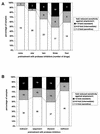Low level of cross-resistance to amprenavir (141W94) in samples from patients pretreated with other protease inhibitors
- PMID: 11036057
- PMCID: PMC101637
- DOI: 10.1128/AAC.44.11.3213-3216.2000
Low level of cross-resistance to amprenavir (141W94) in samples from patients pretreated with other protease inhibitors
Abstract
The therapeutic success of an antiretroviral salvage regimen containing protease inhibitors (PI) is limited by PI-resistant viral strains exhibiting various degrees of resistance and cross-resistance. To evaluate the extent of cross-resistance to the new PI amprenavir, 155 samples from 132 human immunodeficiency virus type 1-infected patients were analyzed for viral genotype by direct sequencing of the protease gene. Concomitantly, drug sensitivity to indinavir, saquinavir, ritonavir, nelfinavir, and amprenavir was analyzed by a recombinant virus assay. A total of 111 patients had been pretreated with 1-4 PI, but all were naive to amprenavir. A total of 105 samples (67.7%) were sensitive to amprenavir; 25 samples (16.1%) were intermediately resistant, and another 25 samples were highly resistant (4- to 8-fold- and >8-fold-reduced sensitivity, respectively). The mutations 46I/L, 54L/V, 84V, and 90M showed the strongest association with amprenavir resistance (P < 0. 0001). The scoring system using 84V and/or any two of a number of mutations (10I/R/V/F, 46I/L, 54L/V, and 90M) predicted amprenavir resistance with a sensitivity of 86.0% and a specificity of 81.0% within the analyzed group of samples. Of 62 samples with resistance against 4 PI, 23 (37.1%) were still sensitive to amprenavir. In comparison, only 2 of 23 samples (8.7%) from nelfinavir-naive patients with resistance against indinavir, saquinavir, and ritonavir were still sensitive to nelfinavir. Amprenavir thus appears to be an interesting alternative for PI salvage therapy.
Figures

Similar articles
-
Amprenavir or fosamprenavir plus ritonavir in HIV infection: pharmacology, efficacy and tolerability profile.Drugs. 2005;65(5):633-59. doi: 10.2165/00003495-200565050-00005. Drugs. 2005. PMID: 15748098 Review.
-
Analysis of HIV cross-resistance to protease inhibitors using a rapid single-cycle recombinant virus assay for patients failing on combination therapies.AIDS. 1999 Oct 22;13(15):2061-8. doi: 10.1097/00002030-199910220-00008. AIDS. 1999. PMID: 10546858
-
Drug resistance and predicted virologic responses to human immunodeficiency virus type 1 protease inhibitor therapy.J Infect Dis. 2000 Sep;182(3):758-65. doi: 10.1086/315782. Epub 2000 Aug 15. J Infect Dis. 2000. PMID: 10950769 Clinical Trial.
-
The pharmacokinetics, safety, and initial virologic response of a triple-protease inhibitor salvage regimen containing amprenavir, saquinavir, and ritonavir.J Acquir Immune Defic Syndr. 2004 Aug 1;36(4):921-8. doi: 10.1097/00126334-200408010-00005. J Acquir Immune Defic Syndr. 2004. PMID: 15220698 Clinical Trial.
-
Coming therapies: amprenavir.Int J Clin Pract Suppl. 1999 Jun;103:42-4. Int J Clin Pract Suppl. 1999. PMID: 10622044 Review.
Cited by
-
Amprenavir or fosamprenavir plus ritonavir in HIV infection: pharmacology, efficacy and tolerability profile.Drugs. 2005;65(5):633-59. doi: 10.2165/00003495-200565050-00005. Drugs. 2005. PMID: 15748098 Review.
-
Pharmacokinetic enhancement of protease inhibitor therapy.Clin Pharmacokinet. 2004;43(5):291-310. doi: 10.2165/00003088-200443050-00003. Clin Pharmacokinet. 2004. PMID: 15080763 Review.
-
Genotypic inhibitory quotient as predictor of virological response to ritonavir-amprenavir in human immunodeficiency virus type 1 protease inhibitor-experienced patients.Antimicrob Agents Chemother. 2003 Feb;47(2):594-600. doi: 10.1128/AAC.47.2.594-600.2003. Antimicrob Agents Chemother. 2003. PMID: 12543665 Free PMC article. Clinical Trial.
-
Amprenavir inhibitory quotient and virological response in human immunodeficiency virus-infected patients on an amprenavir-containing salvage regimen without or with ritonavir.Antimicrob Agents Chemother. 2002 Feb;46(2):570-4. doi: 10.1128/AAC.46.2.570-574.2002. Antimicrob Agents Chemother. 2002. PMID: 11796381 Free PMC article.
-
The Geogenomic Mutational Atlas of Pathogens (GoMAP) web system.PLoS One. 2014 Mar 27;9(3):e92877. doi: 10.1371/journal.pone.0092877. eCollection 2014. PLoS One. 2014. PMID: 24675726 Free PMC article.
References
-
- Adkins J C, Faulds D. Amprenavir. Drugs. 1998;55:837–842. - PubMed
-
- Condra J H, Schleif W A, Blahy O M, Gabryelski L J, Graham D J, Quintero J C, Rhodes A, Robbins H L, Roth E, Shivaprakash M, Titus D, Yang T, Teppler H, Squires K E, Deutsch P J, Emini E A. In vivo emergence of HIV-1 variants resistant to multiple protease inhibitors. Nature. 1995;374:569–571. - PubMed
-
- Craig C, Race E, Sheldon J, Wittaker L, Gilbert S, Moffatt A, Rose J, Dissanayeke S, Chirn G W, Duncan I B, Cammack N. HIV protease genotype and viral sensitivity to HIV protease inhibitors following saquinavir therapy. AIDS. 1998;12:1611–1618. - PubMed
-
- Deeks S G, Grant R M, Beatty G W, Horton C, Detmer J, Eastman S. Activity of a ritonavir plus saquinavir-containing regimen in patients with virologic evidence of indinavir or ritonavir failure. AIDS. 1998;12:F97–F102. - PubMed
-
- Deeks S G, Hellmann N S, Grant R M, Parkin N T, Petropoulos C J, Becker M, Symonds W, Chesney M, Volberding P A. Novel four-drug salvage treatment regimens after failure of a human immunodeficiency virus type 1 protease inhibitor-containing regimen: antiviral activity and correlation of baseline phenotypic drug susceptibility with virologic outcome. J Infect Dis. 1999;179:1375–1381. - PubMed
Publication types
MeSH terms
Substances
Grants and funding
LinkOut - more resources
Full Text Sources
Other Literature Sources
Research Materials
Miscellaneous

